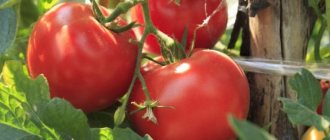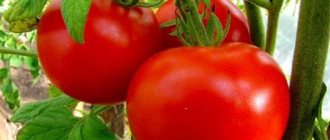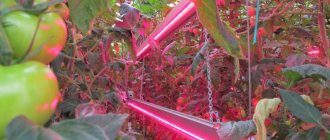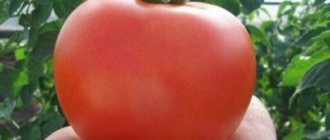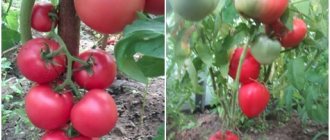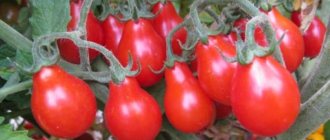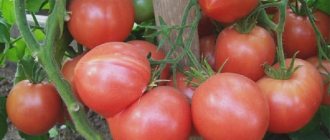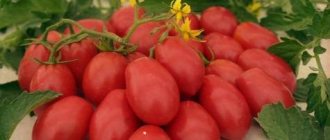Description of the variety
The Volgograd early ripening variety 323 (state register) was developed by crossing Bush Beefstrek and Local crops in 1973. Breeders recommend the variety for cultivation in open ground in the Lower Volga and Central Black Earth regions. In the Urals and Siberia, Volgograd early ripening 323 is recommended to be grown in greenhouse conditions.
Distinctive features
Volgograd early ripening 323 has the following properties:
- early ripening variety (90-100 days);
- determinate type plant - does not require pinching the top to stop growth;
- powerful root system;
- low lush bushes (from 25 to 45 cm);
- leaves are light green, wrinkled, with slight pubescence;
- the first ovary is formed above the 6-7th leaf, then with an interval of 1 leaf;
- inflorescences are simple, intermediate type, bearing up to 6 flowers.
In the State Register of Varietal Achievements there is a variety with a similar name - Volgogradsky 5/95. This culture was bred in 1953 and has slightly different characteristics.
Basic indicators:
- mid-ripening (ripens in 120-130 days);
- suitable for growing in open ground;
- has taller standard-type bushes (70-100 cm);
- produces large fruits (weight reaches 150 g);
- has an intense red color of the fruit;
- has a high yield - up to 10 kg/m2.
Fruit characteristics, yield
The fruits are round in shape, slightly flattened at the ends, red with an orange tint. The tomato skin is thin, dense and shiny. The pulp is juicy, fleshy, sweet.
The average diameter of tomatoes is 7 cm, weight reaches 100 g. Productivity is 4-7 kg/m2.
Harvest and storage
Tomatoes are removed when they turn red, and unripe, brown ones are also removed. They reach maturity when stored.
Unripe ones are easier to transport when grown for sale. Green fruits cannot be picked; their taste is significantly reduced.
Volgograd tomatoes contain a significant portion of dry matter, which allows them to be used for making sauces and canning.
How to grow seedlings
For Volgograd early ripening 323, the seedling method of cultivation is preferable, although direct sowing in the ground is also allowed in the southern regions after the May holidays. Depending on climatic conditions, the summer resident himself decides where he will grow tomatoes - in open or protected ground.
Seed preparation
The seeds of the variety have almost 100% germination and do not require special pre-sowing preparation. You can speed up the germination process by soaking it in a gauze cloth moistened with a weak solution of potassium permanganate for 24 hours.
Container and soil
Any low and wide containers that you have on hand are suitable for sowing.
Tomatoes are demanding on fertility and water-air exchange in the soil. You can buy the substrate for sowing ready-made or prepare it yourself:
- peat - 1 bucket;
- humus - 2 buckets;
- sand - 0.5 buckets.
Add 1 tsp to this mixture. superphosphate, 1 tsp. potassium sulfate and a third of a bucket of wood ash. This soil is slightly acidic in composition, rich in mineral compounds and organic matter, and has good air permeability.
Attention ! Before sowing seeds, the soil needs preventive treatment. The best treatment method is watering with a strong solution of potassium permanganate or biological preparations Fitosporin-M or Trichodermin.
Sowing
Prepared seeds are sown in containers filled with moist soil to a depth of 1.5 cm, the distance between plants is 2-4 cm, between rows - 2 cm. The crops are covered with the same fertile soil and moistened again. The boxes are covered with film to create a greenhouse effect.
Optimal conditions for seed germination:
- temperature 22-25 °C;
- humidity 75%.
The timing of sowing seeds depends on the location of further cultivation of tomatoes:
- for heated greenhouses - February;
- for film greenhouses and greenhouses - the third ten days of March;
- in open ground - 1-2 weeks of April.
Growing and care
As soon as the shoots appear (after 4-5 days), the young seedlings are freed from the film and placed in a well-lit place. Watering should be regular. Seedlings that have not shed their cotyledon leaves are plucked off by hand.
Temperature for normal development of seedlings:
- daytime - 15-20 °C;
- night - 8-12 °C.
Like adult tomatoes, seedlings are fed. Fertilizing with complex mineral fertilizers once every 2 weeks (Kemira Lux, Mortar A) has worked well.
2 weeks before planting, the seedlings are hardened off. If tomatoes are grown in apartment conditions, then arrange through ventilation of the room. If possible, the plants are taken out onto the balcony. When the seedlings reach a height of 15-20 cm, they are planted in open ground.
Important ! If the seedlings have stretched out, they can be saved by picking them into tall glasses with the root collar buried.
Features of tomato
If you own a plot of land, but do not have enough time and experience to grow tomatoes, then the Volgograd early ripening tomato is an ideal option. The culture is so unpretentious that it can grow on any soil. And if the predecessors in the garden were zucchini, cucumbers or legumes, then the tomato harvest will be excellent.
Seedling material can be purchased at the market and planted in a fertilized bed. During the development period, caring for the plant consists of rare but abundant watering, periodic weeding and the necessary fertilizing. The bushes are low, up to half a meter in height, and do not require staking and constant removal of stepsons.
In a very fruitful year, each bush should be surrounded by supports, since due to the abundance of fruits they lose their stability and the stem bends. The first ripe fruits appear in early July. Each bunch produces up to a dozen tomatoes. Unripe tomatoes picked from the bush ripen perfectly in the sun without losing their taste.
How to grow tomatoes
The seedlings are planted in a permanent place at the age of 60 days. For the health of tomatoes, seedlings are not planted the next year after any nightshades. The best predecessors in the garden are cabbage and onions of various types.
Landing
Tomatoes Volgograd early ripening 323 are planted in a prepared bed.
Step-by-step planting technology:
- The holes are prepared deep and wide.
- Plants 20 cm in height are planted one at a time in a hole, at the bottom of which a handful of superphosphate is poured.
- Planting pattern: distance between plants - 40 cm, between rows - 50 cm.
- The soil is added to the first leaves on the trunk.
- A small ditch is created around each plant for quality watering.
- Water generously.
Reference ! The use of the immunomodulator and growth stimulator "Zircon" will speed up the survival and adaptation of seedlings to a new place.
Care
Tomato care measures:
- Watering once every 10-15 days with settled water at room temperature. Excessive soil moisture can lead to fungal diseases and root rot. It is important to water the plants generously and then wait a period of time until the soil dries out.
- Regular weeding as weeds grow.
- Loosening is combined with watering.
- Pinching of Volgograd early ripening 323 is not required. To increase the mass of fruits, you can remove each stepson up to 1 cluster.
- Shaping the bush. In determinate tomatoes, bushes are formed into 2-3 stems, removing excess shoots. The lower large leaves are also removed. Removal of stepsons is carried out in cloudy weather.
- Plants do not require staking.
- To obtain a high-quality harvest, regular feeding is important - once every 10 days. It is recommended to alternate organic and mineral fertilizers.
Features of cultivation and possible difficulties
Volgograd early ripening 323 is an unpretentious crop. The only difficulties that may arise when growing it are waterlogging of the soil and lack of nutrition. These factors can be easily eliminated by correcting agricultural practices.
Diseases and pests
The variety has fixed resistance to late blight, anthracnose, cladosporiosis, blight and rot.
If the weather is damp in the summer, to prevent fungal diseases, the greenhouses are regularly ventilated, and the plantings are treated with copper preparations (copper sulfate, “HOM”).
Tomato varieties for open ground, video
If you grew Volgograd early ripening tomatoes, please write whether you liked them or not. How did this variety perform in your climate? How do you rate tomato disease resistance? If possible, attach to the comment a photo of the entire bush as a whole or individual fruits that you grew. Thank you!
You can see other interesting varieties and hybrids of tomatoes with photos, descriptions and reviews in our Tomato Catalog. Enjoy watching.
Your reviews of the Volgograd tomato and additions to the description will help many gardeners evaluate this variety objectively and decide whether it is worth planting or not.
Advantages and disadvantages of the variety
Volgograd early ripening 323 has a lot of useful qualities:
- precocity;
- productivity;
- does not require pinching;
- adapted to temperature changes;
- Resistant to major nightshade diseases.
No significant deficiencies were identified in the variety. The plant reacts to extreme heat by reducing the ovaries. This property is due to the physiology of the plant, since when exposed to high temperatures, pollen becomes sterile.
Positive and negative sides
Advantages of Volgogradsky 323:
- early fruit ripening;
- high taste qualities;
- convenience of preserving medium-sized identical tomatoes;
- easy care;
- resistance to pests and diseases;
- good safety during transportation and storage.
This tomato has no disadvantages. It fully serves its purpose.
Farmer reviews
Several reviews from gardeners about this reliable and popular variety.
Elena, Samara region: “Of all the tomatoes that I planted, only this one turned out. The downside is that the taste is typical for sophisticated people, the appearance of the tomatoes is uninteresting, however, the same as in the photo on the packaging.”
Nikita Vladimirovich, Zelenograd: “I’ve been growing it for 3 years now. I go to the dacha once a week. This variety was a godsend for me! Grows without any problems. You can water once a week.”
Marina, Kherson: “The endurance of plants is amazing. I grow it in open ground. One day I was in a hurry to plant seedlings, and they got frostbitten. I thought they would die. But the plants grew back and gave a good harvest.”
Diseases and pests
For tomatoes growing in unprotected soil, prevention from diseases and pests is mandatory. This variety is resistant to diseases, but spraying with Bordeaux mixture (1%) or infusions of garlic and potassium permanganate will not be superfluous.
Thanks to the early and friendly yield of the harvest from late blight, Volgogradsky 323 manages to “escape”. But if plant diseases begin early, you will have to spray with whey, ash infusions, and also use chemicals.
Volgograd tomato: description of characteristic features
Volgograd tomato: description of characteristic features
Most Volgograd tomato varieties are similar, but there are still some differences. The varieties differ in the size of the bushes, fruits and ripening period. Volgograd, nouns, favorite among many gardeners. After many years, the relevance and quality of Volgograd tomatoes remains at a high level.
The first characteristic feature of Volgograd tomatoes. These varieties are unique because they have small bushes that do not require supports or pinching.
The second characteristic feature of Volgograd tomatoes.
These tomatoes are good because they can themselves control the number of fruits that can grow on the bush so that it does not break or get damaged.
The third characteristic feature of Volgograd tomatoes. The fruits are quite small, but very tasty.
The fourth characteristic feature of Volgograd tomatoes.
The Volgogradsky 595 variety has fruits slightly larger than other varieties, but the taste is approximately the same.
The fifth characteristic feature of Volgograd tomatoes. Do you know that tomatoes often carry various diseases? Perhaps one of the main advantages of Volgograd tomatoes is that they are practically not susceptible to various infections. Some varieties can protect against fusarium and other dangerous diseases.
Pros and cons of the tomato variety Volgogradsky 5/95
The hybrid is not new, so it has both positive and negative qualities.
Among the advantages of tomato it is worth noting:
- Compactness, medium foliage of the bushes, which makes caring for the crop easier.
- Drought tolerance.
- Easily tolerates temperature changes.
- The brush can ripen up to 5 fruits at the same time.
- With different weights, the shape is the same, so tomatoes are suitable for whole-fruit canning.
- Resistance to a number of fungal diseases.
- Transportability.
- Ripe tomatoes do not burst.
- Can be stored for a long time.
The disadvantages of the Volgogradsky 5/95 tomato variety include:
- demands for complex feeding;
- the need to tie up bushes;
- low yield;
- fragility of shoots.
Recommendations for growing the variety
The Volgograd tomato is one of the most undemanding varieties. Knowledge of some features of agricultural technology will allow you to grow an abundant and tasty harvest on your site.
Seed
The period of planting Volgograd tomato seedlings lasts from February to April. Seeds of tall subspecies must be planted in February, and low-growing ones - in March.
It is important to calculate the time correctly: with very early planting, a lack of light and a long stay in a cramped container will negatively affect the development of plants.
Tomato seeds
Sequencing:
- Before sowing into the ground, seeds must be sorted and those that are too small or damaged must be eliminated.
- To increase germination, leave the planting material in a manganese solution for 25-30 minutes.
- The nutritious soil required for planting can be purchased at a garden center or mixed independently from peat, humus and turf soil in equal proportions. Then pass the resulting substrate through a sieve and compact it tightly into the container.
- Place the seeds in the soil to a depth of 3-5 cm, at a distance of 3-4 cm.
- Spray the soil with a garden sprayer and cover the containers with film on top. The room temperature should be no less than 10 and no more than 20 oC.
When the first few leaves appear, the seedlings can be moved to larger containers for the growth of the root system.
Seedling
The seedling method is the most common for the Volgograd tomato:
- To obtain a healthy and abundant harvest, it is important to prepare the planting site in advance, in late autumn. Dig up the soil, then fertilize it with humus and mineral complexes. In spring, dig up the soil again, this time with the addition of ammonium nitrate.
- Plant seedlings in deep enough holes to ensure normal development of the root system.
- Fill the seedlings up to the first leaves. It is not advisable to fill the hole completely with soil: it will be enough to dig it halfway for ease of watering.
Tomato seedlings
After 2-3 days, the seedlings will begin to reach for sunlight: on especially hot days they need additional protection from direct rays to avoid burns.
What do the fruits look like?
Volgograd tomatoes can be recognized by their round shape and light ribbing on the surface. At first, light green fruits appear, which become rich red as they ripen. On average, each weighs from 70 to 90 g. Tomatoes are quite dense, with fleshy juicy pulp and a bright tomato taste, characterized by a characteristic sourness.
The fruits are universal in use. Due to the rich amount of microelements in the composition, they are especially useful for fresh consumption. More mature tomatoes are great for various dishes, pasta, ketchup, and juice. The thick skin retains its shape well, so the tomatoes do not crack and are convenient to use for preservation.
Optimal growing conditions
Tomatoes of the Volgograd early ripening variety 323 can be grown in the open air and under cover. To harvest an early harvest, you need to wisely choose a site for planting, prepare the soil and, despite its unpretentiousness, follow simple care.
The area for tomatoes is chosen in a well-lit place. The best predecessors are root vegetables, legumes and cereals. It is better to prepare the soil in the fall. To do this, dig up the soil, add rotted compost and a mineral fertilizer complex. The beds are covered with a 15 cm layer of hay and watered generously. After such preparation in the spring, the soil will become fertile and fluffy, and the rotted hay will act as an additional organic fertilizer.
Productivity
When purchasing seedlings, pay attention to appearance
Growing this variety of tomatoes makes it possible to get up to 4.5-5 kilograms of fruit per square meter. About 3-4 bushes are planted on a plot of land of this size. How to do this correctly can be found in the videos that are publicly available on the Internet. But the yield of tomatoes depends on:
- the conditions in which the seedlings were grown;
- timely proper feeding of flowering and fruiting tomatoes;
- soil quality;
- weather conditions;
- soil moisture.
If seedlings are purchased in nurseries or from hand, then you should pay attention to their appearance. Sick and stunted seedlings will give a very meager harvest, regardless of the variety
Among other things, there is a danger of pathogens of fungal diseases being introduced into the soil through poor-quality planting material.
